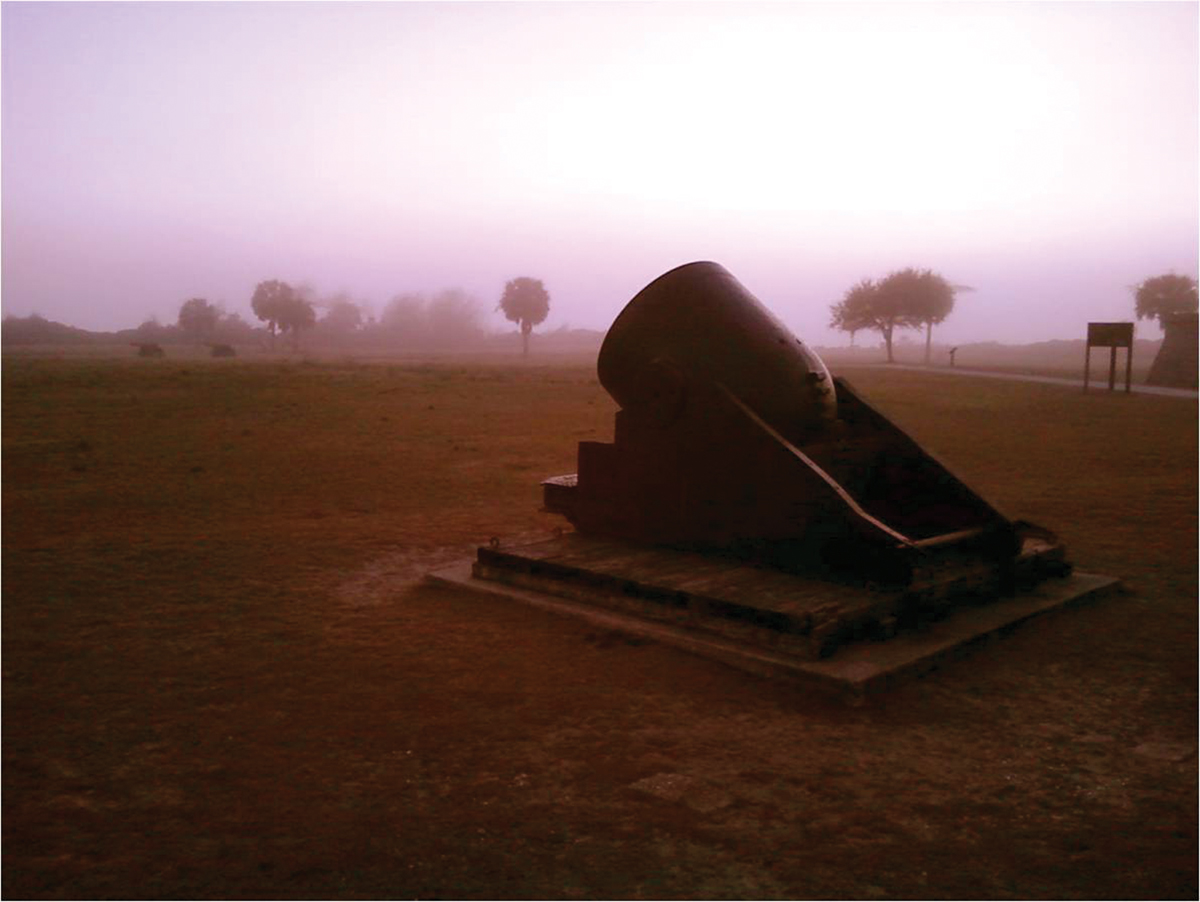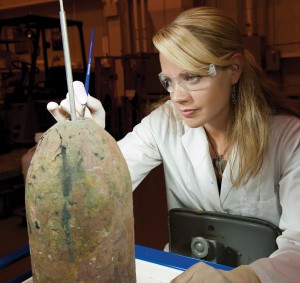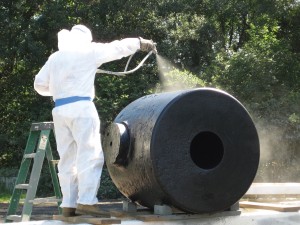This time, the foe is corrosion
Brian Mullen

A thirteen-inch seacoast mortar tube before treatment at Fort Moultrie’s Cannon Row. Photo courtesy of the Lasch Center.
On April 12, 1861, Confederates opened fire on Fort Sumter in South Carolina’s Charleston Harbor, unleashing what historians have said was the longest bombardment in the history of the western hemisphere. Artillery battered the fort for thirty-four consecutive hours before Major Robert Anderson and his Union forces surrendered.
A century and a half later, traces of the battle remain. Under a Cooperative Extension Studies Unit agreement, Clemson University Restoration Institute’s Warren Lasch Conservation Center and the National Park Service have teamed up to safeguard Fort Sumter and nearby Fort Moultrie, along with their architecture and historic metal artifacts.

Liisa Näsänen, a conservator who manages the project, works on an artillery shell in a laboratory at the Lasch Center. Photo by Ray Stanyard.
Conservation, shell by shell
Clemson and National Park Service research aims to develop assessment, treatment, and maintenance protocols applicable to the entire collection of weaponry at Fort Moultrie and Fort Sumter. The idea is to preserve the forts’ cultural heritage— including the cannons, artillery platforms, doors, railings, steps, and many small artifacts now in the park’s museum collection.
Last December, Clemson conservators worked meticulously to preserve three Union shells implanted in the masonry wall at Fort Sumter, silent reminders of the estimated forty-five thousand artillery rounds fired at the fort during the five years of conflict.
Liisa Näsänen, a conservator who has managed the collaborative project at the forts since 2009, ultimately decided to preserve the artillery shells within the fort’s wall since removing them may have further crippled the nineteenth-century structure. These shells had to be preserved in place, a challenge quite different from the conservation of objects transportable to the best location and conditions.
Näsänen and her team removed as many salts from the metal as possible, hindering active iron corrosion, and then dried the shells before applying a material to help consolidate the iron on the shell to prevent further damage to the metal.
The conservators admit that protecting objects from outdoor conditions is a challenge. “It’s always something we have to battle with outdoor projects,” Näsänen says. “We have to look at the humidity and the temperature and factors like that. We have to not only look at the artifact itself, but also the conservation materials we use to make sure they are compatible with the object and the environment.”
Today, the shells are visible to the 325,000 people who visit the fort each year.
The major part of the first phase of the Lasch Center collaboration with the National Park Service was dedicated to assessing the two forts, setting priorities for treatments and conservation protocols based on a complex set of factors such as condition assessment, results from analytical testing, and the historic significance of the item and its need for treatment. Six cannons inside Fort Moultrie and at its cannon row were in urgent need of care, as were several architectural items. Stéphanie Cretté, the Lasch Center’s chief research scientist, collaborated with Näsänen, providing analytical and coating expertise.

A contractor applies a polyurethane topcoat to a 13-inch seacoast mortar tube. Photo courtesy of the Lasch Center.
High-tech preservation
Although major artifacts at Fort Moultrie were preserved using traditional conservation methods, several smaller iron artifacts from the park’s museum collection were conserved using subcritical fluid technology to stabilize the corroding iron (see Ridding metal of salt). So far, five rare Civil War artillery shells and nine other artifacts have successfully undergone this conservation method. The National Park Service sponsors and participates in this state-ofthe-art preservation technique, developed by Néstor González-Pereyra, a chemical engineer at the Lasch Center.
Now under way, the project’s next phase homes in on the conservation needs at Fort Sumter. Artifacts there will mostly require conservation in place. The fort is in the middle of Charleston Harbor, and moving artifacts such as cannons from the fort to a conservation lab would involve risky, expensive, and complex logistics. These projects with National Park Service have not only supplied valuable information to the park staff but have also provided a number of Clemson students with real-world training and experience in caring for the nation’s cultural heritage.
Work described in this article has appeared in “Coating Challenges in Cultural Heritage Conservation,” written by Stéphanie Cretté and Liisa Näsänen and published in the journal Coatings Tech, 2012. Brian Mullen is the director of research communications in Clemson’s Office of Public Affairs.


